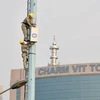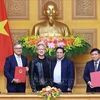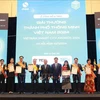Three unmanned aerial vehicles (UAV) successfully completed trial flights for the first time at the Space Technology Institute of the Vietnam Science and Technology Academy in Hanoi on May 3.
The three vehicles were among five UAVs manufactured by the institute as part of a State scientific research project.
The successful test fights mean that the project's engineers and staff have become the first Vietnamese people to successfully research and build UAVs in Vietnam, said the project director Pham Ngoc Lang.
They will be used for scientific research serving socio-economic development, such as the study of desertification, the impact of climate change and deforestation in Tay Nguyen (Central Highlands), Lang added.
The director confirmed that the institute will now focus activities on expanding the flying range and technology of the vehicles in preparation for mass production.
Of the three tested UAVs, the smallest (1 metre long and 1.2 metres wide) has an operation radius of 2 kilometres and can reach a height of 200 metres and a speed of 70 kilometres per hour.
The second biggest (1.8 metres long and 2.7 metres wide) can travel as far as 15 kilometres at speeds of up to 120 kilometres per hour and heights of 3,000 metres. It can take off from a 200-metre runway or a launching platform and it can land by runway or parachute. It is capable of sending data remotely.
The largest craft (2.6 metres long and 3.2 metres wide) can fly for three hours at speeds of 150 kilometres per hour. All three are equipped with high-resolution cameras.
The UAVs are all operated using an automatic control system following programmes set on a digital map foundation.
Former Minister of Post and Telecommunications Do Trung Ta said that the successful test of the UAVs was a milestone in Vietnam's scientific research, especially in cybernetics and information technology.-VNA
The three vehicles were among five UAVs manufactured by the institute as part of a State scientific research project.
The successful test fights mean that the project's engineers and staff have become the first Vietnamese people to successfully research and build UAVs in Vietnam, said the project director Pham Ngoc Lang.
They will be used for scientific research serving socio-economic development, such as the study of desertification, the impact of climate change and deforestation in Tay Nguyen (Central Highlands), Lang added.
The director confirmed that the institute will now focus activities on expanding the flying range and technology of the vehicles in preparation for mass production.
Of the three tested UAVs, the smallest (1 metre long and 1.2 metres wide) has an operation radius of 2 kilometres and can reach a height of 200 metres and a speed of 70 kilometres per hour.
The second biggest (1.8 metres long and 2.7 metres wide) can travel as far as 15 kilometres at speeds of up to 120 kilometres per hour and heights of 3,000 metres. It can take off from a 200-metre runway or a launching platform and it can land by runway or parachute. It is capable of sending data remotely.
The largest craft (2.6 metres long and 3.2 metres wide) can fly for three hours at speeds of 150 kilometres per hour. All three are equipped with high-resolution cameras.
The UAVs are all operated using an automatic control system following programmes set on a digital map foundation.
Former Minister of Post and Telecommunications Do Trung Ta said that the successful test of the UAVs was a milestone in Vietnam's scientific research, especially in cybernetics and information technology.-VNA



















